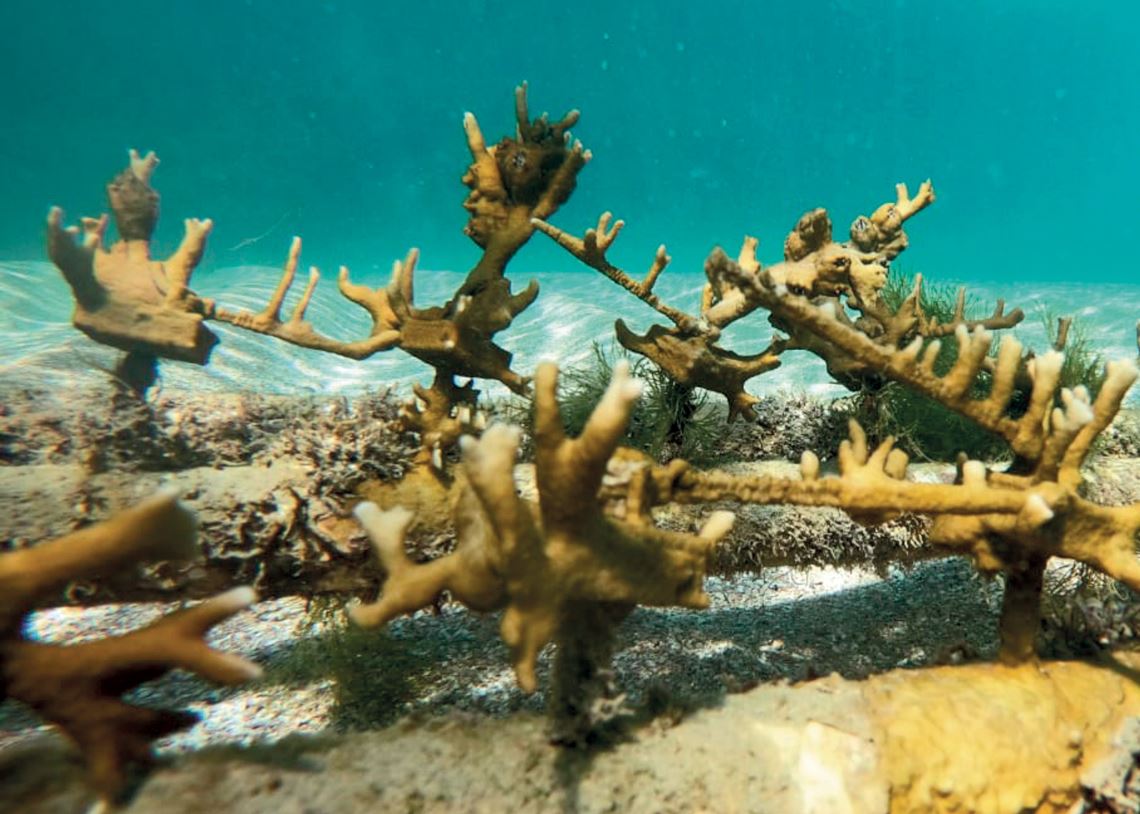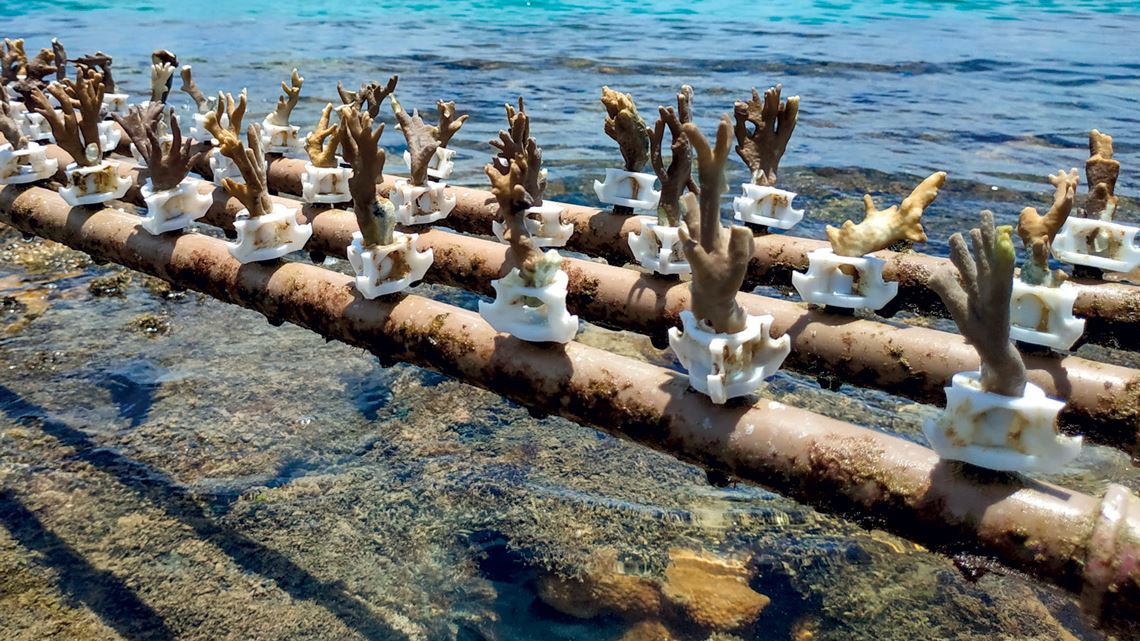An innovative technique conceived at the Federal University of Pernambuco (UFPE) may help preserve coral reefs. Scientists from Biofábrica de Corais, a project linked to the Luiz Accioly Enzymology Laboratory (LABENZ) at UFPE’s Department of Biochemistry, have developed a kind of cradle to cultivate fragments of endangered coral species. Each piece of coral grows in a cradle for a few months until it is ready to be transferred permanently to places that have lost their original reef. A pilot project is being conducted in the natural pools of Porto de Galinhas beach, a popular tourist destination in Ipojuca, 50 kilometers from Recife, the state capital.
Corals are invertebrate animals formed of small soft-bodied polyps, connected to each other by a calcareous skeleton. The technique created at UFPE, capable of making the transplantation process simpler and more accessible, has the potential to mitigate reef degradation caused by ocean pollution and warming. When marine environments are affected by oil spills, for example, which can lead to sudden temperature increases, one of the consequences is coral bleaching, where the coral polyps expel zooxanthellae, a microalgae that lives inside their tissues and gives them their color. Bleaching can kill the polyps, leaving only the white calcareous skeleton.
Biofábrica’s work, which started six years ago, has already resulted in two patent applications for devices related to the cultivation of corals and sea sponges. “We want to promote a multidisciplinary approach to coral conservation and involve the local community, allowing them to see the process from the perspective of economic sustainability,” explains fishing engineer Rudã Fernandes, scientific coordinator for the project, which has 34 members, including biologists, engineers, designers, communications professionals, and sailors, of which 17 are permanent employees and the rest occasional collaborators.
The group cultivates two species in the nursery in Porto de Galinhas, also known as a coral farm: fire corals (Millepora alcicornis) and brain corals (Mussismilia harttii). The latter have been at risk of extinction since 2014 and are considered one of the most important reef building species thanks to their stony composition. Fire corals, whose branches offer shelter to various aquatic organisms, are endangered because they are more sensitive to sudden changes in water temperature, which can occur as a result of global warming, but also due to exposure to low tides or increased water temperatures in shallow natural pools.
So far, the coral cultivation results have been encouraging. Fire corals can grow by 40% in 90 days and brain corals triple in size in 120 days. Within three months, according to Fernandes, they are able to fully colonize the nursery and are completely recovered from the stress of the management process. “But we are still investigating the ideal amount of time for them to stay in the nursery before being transplanted into a marine environment,” says the researcher.
Global challenge
Coral reefs are found in less than 0.1% of the world’s oceans, but are home to 25% of marine biodiversity—hence the importance of preserving them. In addition to sustaining so much life, these colonies form an environment that offers coastal protection, abundant fishing grounds, a source of bioactive ingredients for the pharmaceutical and cosmetic industries, and a popular tourist attraction. They are, therefore, an important source of wealth to local communities.
According to the Coral reef restoration report published this year by the United Nations Environment Program (UNEP) and the International Coral Reef Initiative (ICRI), there are coral reefs in more than 100 countries worldwide, and at least 500 million people depend on them for subsistence. The document estimates that if Australia’s Great Barrier Reef had a market value, it would be worth US$56 billion, with related economic activities generating US$6.4 billion per year.
This abundance of resources, however, is under threat. Coral reefs are one of the ecosystems most vulnerable to climate change and human activities. It is estimated that half of the world’s reefs have been destroyed in the past 30 years, and an even larger portion may disappear in the coming decades if global warming is not stopped. “As an example of the scale of the threat faced by corals, a heat wave in 2020 caused the bleaching of about 80% of the fire corals in Porto de Galinhas,” warns Fernandes. “In this acute situation, we need to work fast. Otherwise, five years from now, we may have nothing left to save.”
 Carlos Dos Santos / Ecojangada
Carlos Dos Santos / Ecojangada
A review led by biologist Lisa Boström-Einarsson of James Cook University in Queensland, Australia, analyzed more than 360 restoration projects in 56 countries and noted that 70% of the initiatives involve coral nurseries. In Brazil, the UFPE project is one of the pioneers. Other strategies used around the world to recover corals include onshore laboratories for accelerating coral growth, direct transplantation without the use of nurseries, and the removal of competing organisms.
“Coral cultivation and restoration is not a novelty in itself. This has been going on for a few decades now. In the long term, the approach has shown promise in the Caribbean, Thailand, and Florida, USA. In periods of 8 to 12 years, these regions saw greater coral coverage and greater structural complexity in locations that had undergone restoration than non-restored areas,” says biologist Alberto Lindner of the Federal University of Santa Catarina (UFSC). “It is important, however, to emphasize that transplantation should be seen as a last resort for conservation. Preventive measures, such as avoiding overfishing, controlling ocean pollution, and establishing conservation units can be cheaper and prevent damage to coral reefs.”
In Pernambuco, the innovation recently developed by the UFPE team is in the parts used as the cradles where the corals will be grown. They are made of the biodegradable polymer PLA (polylactic acid) using 3D printers. On land, this material degrades in about a year, but researchers still do not know how long it will take to decompose at the bottom of the sea. One of the novel aspects of the structure is that it is designed to adapt to the morphology of different species, which can accelerate their growth (see infographic below). “Sea sponges and corals are animals associated with the substrate, and they develop on a fixed surface. But in many nurseries, we saw them hanging from cords; and we wanted to do things differently. When we fixed the sponges onto a surface, the results were better, and then we tried the same approach with the corals,” says Fernandes.



